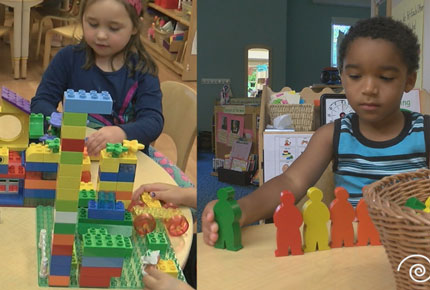What Makes a Good Toy?
Summary of Lessons Learned
#1: Simple
Many toys on the market today have complicated bells and whistles—they make noise; they light up; they talk. In many cases, these items function more as entertainment than toys that actively engage children in rich play. Our research has found that simpler is better. For example, a simple wooden cash register in our study inspired children to engage in lots of conversations related to buying and selling—but a plastic cash register that produced sounds when buttons were pushed mostly inspired children to just push the buttons repeatedly. Similarly, a doll that does the talking for a child will generally result in play that is less imaginative than a simple doll where children have to imagine for themselves what the doll might say.
#2: Open-ended
Some toys suggest to children exactly how to play with them, and these kinds of toys can certainly be valuable. For example, puzzles and board games help children learn to solve specific problems, follow rules, and take turns. A set of construction vehicles may motivate children to learn more about (and then act out) the functions of a bulldozer vs. front loader vs. steam roller. But the toys in our study that inspired children to be the most creative didn’t suggest just one way to play—they were open-ended and flexible, which allowed children to come up with their own ideas. We observed children using plain hardwood blocks to create houses, zoo enclosures, castles, and roads—and children pretended that individual blocks were cell phones, cars, or sandwiches. In addition, open-ended toys in our study tended to hold children’s attention for a longer period of time.
#3: Non-realistic
Some toys are exact replicas of things in real life, and these can inspire certain kinds of positive play. For example, a set of plastic dishes may lead to elaborate pretend play with lots of conversation as children pretend to prepare and serve a meal to their peers or to an adult. However, we found that non-realistic toys—or toys that didn’t look like something that exists in real life—were especially powerful. When building with a basic set of Legos, children must make their own decisions about what they’re creating, and then they must communicate their ideas to their playmates. This kind of play often results in complex problem-solving as children work to bring their vision to life, creativity as they conceive of new ways to put together pieces, and rich interactions and conversations with peers as they discuss their creations and then use them in pretend play.
Two Kinds of Toys That Are Especially Powerful
While we found something positive in many different categories of toys, our study found that two types of toys consistently resulted in high-quality play among preschoolers:
- Construction toys such as hardwood blocks, Legos, TinkerToys, Magna-Tiles, and other toys with multiple pieces that children can put together in a variety of ways did well every year of our study. The best construction toys for preschoolers are open-ended (e.g., not a kit for making a specific product) and have enough pieces that children have the flexibility to build many different things.
- Replica play toys such as small people, animals, or vehicles also did well in our study over multiple years. When playing with these toys, children create elaborate, make-believe scenarios, and they engage in rich conversation and cooperative play with their peers.



